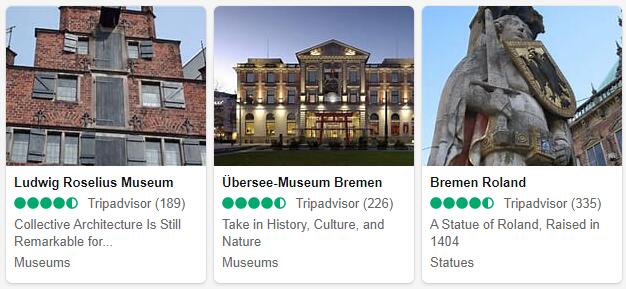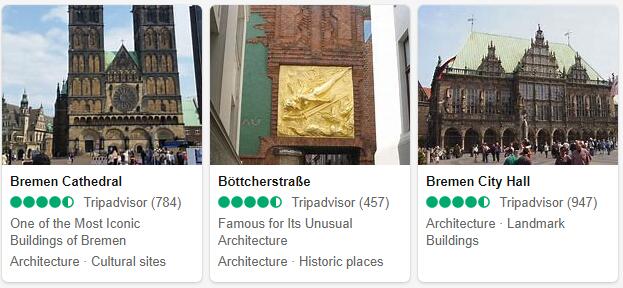Bremen Attractions
The city Hall
Am Markt 21
This very beautiful building was made in the early 1400s and the façade is in the Renaissance style and made in the 1600s. The building is on UNESCO’s World Heritage List.
Roland statue
The Am Markt
Roland Statue is Bremen’s answer to New York’s Statue of Liberty, and this statue is the largest Roland statue in all of Germany. The statue symbolizes the city’s commercial rights and freedom and has been doing so since 1404. The statue is also on UNESCO’s World Heritage List.
St Peter’s Cathedral
This cathedral / church dates back to the year 800. Today’s church dates from the 13th century and has Gothic architecture. St. Peter’s Cathedral today functions as a Protestant church and is open from 1000 to 1700 on weekdays, 1000 to 1400 Saturdays and 1400 to 1700 Sundays.
Please note that St Peter’s Cathedral also has a museum with interesting objects.
St. John’s Provost Church
Klosterkirchenstrasse
This 13th-century Gothic church found in the Schnoor district is the most important Catholic church in Bremen. This was formerly a Franciscan church.
St. Stephen’s Church
Stephanikirchhof 8
This church was built in 1139 and destroyed during World War II, more specifically in 1944. The church was built in 1950 and is not least known for its Beckerath organ. There are often concerts in the church.
Kunsthalle Bremen
Am Wall 207
Here you will find paintings and sculptures from the 1300s to modern times. The museum also has one of Europe’s largest collections of German and French impressionists. Open every day of the week except Mondays. Opening hours are from 1000 to 1700, but long open Tuesdays. Entry fee about 50 kroner and half price for children. More info on Kunsthalle’s website.
Weserburg Museum of Modern Art
Teerhof 20
At the Weserburg Museum you will find modern art from all over the world. The museum is considered among the best in Europe in its genre. Open all days, except Mondays. Entry price about 50 NOK and about half price for children.
Bremen’s Radio Museum
Findorffstrasse 22-24
If you are interested in media and technology then do not miss the Radio Museum. Open Monday to Friday from 1000 to 1600. Only NOK 20 in entrance fee.
Bremen Musical Theater
Richtweg 7-13
This beautiful musical theater with about 1400 seats has daily performances that are well worth a visit. You can also relax in the theater’s elegant bar or dine in its fine restaurant. Trams 4,5,6 and 8 until Herdentor take you to the Musical Theater.
Bürgerpark
At the Swiss House you will find the most famous park in Bremen. Bürgerpark or the people’s park is among the most well-maintained parks in all of Germany and a favorite excursion destination. You reach the park by tram 6 and 8 or bus 24 to Am Stern or bus 26 and 27 to Bürgerpark.
Casino Bremen
Böttcherstrasse 3-5. Here you can play poker, roulette, blackjack and of course slot machines. Open from 1500 to 0300 every day.
Cinema 46
This is a very special cinema that shows experimental films, classic films and holds a variety of different film festivals. If you are a movie enthusiast then head to Waller Heerstrasse 46. Take tram 2 or 10 to Gustavstrasse.
Bremen Tourist
Bremen is an old Hansaby located northwest of Germany, along the Weser River. Bremen has had strong contact with Scandinavia for centuries and was an important driver in the introduction of Christianity in Northern Europe.
Interestingly, Bremen has almost always been independent. With the exception of a French occupation in the 19th century, and during Nazism from 1933 to the end of the world war in 1945, Bremen was an autonomous (independent) city-state. Only in 1949 did Bremen become part of the Federal Republic of Germany. Bremen was naturally severely affected during World War II, but the city has been rebuilt into one of the finest in Germany.
Today, Bremen is perhaps best known for its beer production, which is of the highest quality. After all, Bremen is the hometown of world-renowned Beck’s beer. Bremen is a prosperous city with a rich and varied business community. the place where Mercedes-Benz makes its luxury cars. Bremen is also an important port city.
Bremen as a tourist town
Being a tourist in Bremen is easy. Not only because the attractions are easy to reach on foot, but also because the city has more than a thousand beer nooks, bars, cafes and restaurants, as well as a variety of music scenes and museums. All in all, this gives us a wealth of diversity significantly richer than we might expect from a city that, including its surrounding areas, counts about 700,000 inhabitants. In addition, the inhabitants of Bremen are known for their hospitality. The city is simply a German charm of a city.
Marketplace and downtown
Bremen’s marketplace is considered by many to be one of the most beautiful in Europe. And this is where you will find the magnificent City Hall and other historic buildings. It is not difficult to see that the place and surroundings are influenced by the Baroque and the Renaissance. The town hall dates back to the early 1400s, but there are considerably older buildings. For example, St Peter’s Cathedral is more than 1,000 years old. At the market square you will also find the Roland statue, the symbol of Bremen’s freedom, erected in 1404. The 1996 parliament building is the modern counterpart to the other buildings at the market square.
A central street in Bremen is the Bürgermeister-Smidt-Strasse. It crosses the Weser River, passes the Teerhof, which projects into the river like a peninsula and where you will find the Neues Museum, and continues on Weser’s southwest side where the street changes its name to Langemarckstrasse. Another central street on the west side is Westerstrasse which crosses the Langemarckstrasse. On the northeast side of the river, the Bürgermeister-Smidt-Strasse crosses the tourist streets Schlachte, Martinistrasse and Am Bril.
Schlachte
The area in and around the street Schlachte in the center of Bremen clings along the northeastern shores of Weser and is thus a little further south than the marketplace. In recent years, slaughter as an area has received a new spring and attracts people in droves. Here you wander among pubs, restaurants and refurbished buildings, while sailboats and other boats pass up and down the river.
Böttcherstrasse and Martinistrasse
Martinistrasse is the main street that runs parallel to Schlachte along the Weser River. Whether you follow one or the other of these streets, you will reach the artist street in Bremen, Böttcherstrasse. The buildings in the area appear in a perfect combination of traditional and expressionist architecture. It has been a major construction project and was only completed in 1934. Every day at 1200, 1500 and 1800 you can hear chimes in the streets. As part of the chimes you will see famous seafarers wandering around to the sound of the chimes. Böttercherstrasse is not far from the market square and attractions such as St Peter’s Cathedral, Pfarrkirchen and the Statue of Liberty Bremer Roland.
Schnoor
Schnoor is located a little southeast of the town hall and downtown. You can follow Martinistrasse to the end of the road and continue along the street Tiefer. If you live on the west side of Weser you can cross the river with the help of the Wilhelm-Kaisen-Brücke street. Schnoor is a central part of the historic center and consists of medieval buildings and narrow alleys. Once upon a time, the district was populated by fishermen who lived off the river, craftsmen and traders. Today, Schnoor is the place where you will find nostalgic pubs and bars, quality restaurants, cozy cafes and exclusive specialty shops. The oldest houses you see now are from the 16th century, but the district dates back to the 13th century.
If you continue further southeast from Schnoor you will reach the park Wallanlagen and Kunsthalle Bremen.
Windmill town
Bremen is in fact also called the wind turbine town and this is of course because there are wind turbines in and around Bremen. Five old traditional wind turbines still exist and the wind turbine found in the Oberneuland district is open as a museum. In the inner city you will see a windmill on the city wall. It was in operation until 1950 and today functions as a landmark on the remains of the Wallanlagen Fortress. The fort was officially demolished in 1802 and turned into a park.

